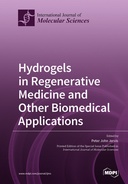Explore

Hydrogels in Regenerative Medicine and Other Biomedical Applications
0 Ungluers have
Faved this Work
Login to Fave
Great strides have been made in the area of hydrogel science since the first hydrogels were described in the 1960s. Hydrogels usually consist of three-dimensional matrices of hydrophilic polymers, held together by chemical or physical crosslinks, or supramolecular assemblies of small amphiphilic molecules. The gelation process occurs in response to a physical or chemical stimulus, such as temperature, pH, electric or magnetic field, enzymatic modification, light, and others. Consisting of mainly water molecules, they represent a unique class of materials, with many applications such as cell therapeutics, cartilage/bone regeneration, sustained drug release and drug delivery systems, tissue engineering, and 3D bioprinting. Despite these great strides, there is still much more to discover in this area. This Special Issue is focused on the use of hydrogels in tissue and bone regeneration. Hydrogels are particularly suited for this purpose as their physical characteristics resemble that of the extracellular matrix; as such, they have found applications as an extracellular medium for cancer cells, stem cells, and neuronal cells. This Special Issue also includes research papers on the other biomedical applications of hydrogels.
This book is included in DOAB.
Why read this book? Have your say.
You must be logged in to comment.
Rights Information
Are you the author or publisher of this work? If so, you can claim it as yours by registering as an Unglue.it rights holder.Downloads
This work has been downloaded 58 times via unglue.it ebook links.
- 58 - pdf (CC BY) at Unglue.it.
Keywords
- 3D printing
- 3D scaffold
- acute wounds
- adipose tissue regeneration
- alginate
- Angiogenesis
- animal model
- antibacterial
- antibacterial ability
- antibacterial and antioxidant wound dressing
- B cell survival
- beta-cyclodextrin
- betamethasone
- Biochemical engineering
- Biocompatibility
- Biomaterials
- bioprinting
- Biotechnology
- burn wounds
- Cancer
- carpal tunnel syndrome
- cartilage tissue engineering
- Cellulose
- Chit-HVP
- Chit-RGD
- chitosan
- chronic lymphocytic leukemia
- Chronic wounds
- cobalt-substituted hydroxyapatite
- decellularization
- decellularized cartilage matrix
- dECM hydrogel
- deep detection
- dehydrodipeptide
- diabetic foot ulcers
- diabetic wounds
- Drug delivery
- entrapment neuropathy
- Extracellular matrix
- fertility preservation
- fibrinogen
- focal adhesion kinase (FAK)
- functionalization
- fusion
- h-osteoblasts
- hemostatic dressing
- human gingival fibroblast
- human hair keratin
- hybrid hydrogel
- hydrogel
- Hydrogels
- in vitro model
- injectability
- injectable hydrogel
- kaolin
- LCST adjustment
- marjoram oil
- methacrylate glycol chitosan
- microenvironment mimicking matrix
- myoblast
- myogenic differentiation
- n/a
- Nanoparticles
- necrosis inhibitor
- NEXAFS
- PDGF
- peptidomimetic
- phononic crystal
- PLCL
- PNIPAM-based graft copolymers
- poly(2-hydroxyethyl methacrylate)
- poly(sodium-4-styrenesulfonate)
- poly(vinyl alcohol)
- Polyvinyl Alcohol
- PVA
- RGDS
- rheological properties
- shear-responsive
- Smart materials
- sodium alginate
- sol–gel transition
- spermatogonia stem cells
- supramolecular
- synthetic mimic of heparin
- Technology, engineering, agriculture
- Technology: general issues
- testicular tissue transplantation
- thermo-responsive
- thiol-ene cross-linking
- tissue bio-adhesive
- Tissue Engineering
- triclosan
- tunable lens
- ultrasonic detection
- ultrasound
- vascular maturity
- VEGF
- wound dressings
- Wound healing
- XPS
Links
DOI: 10.3390/books978-3-0365-7250-5Editions

